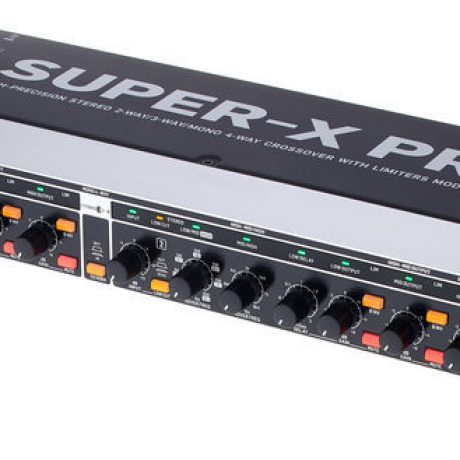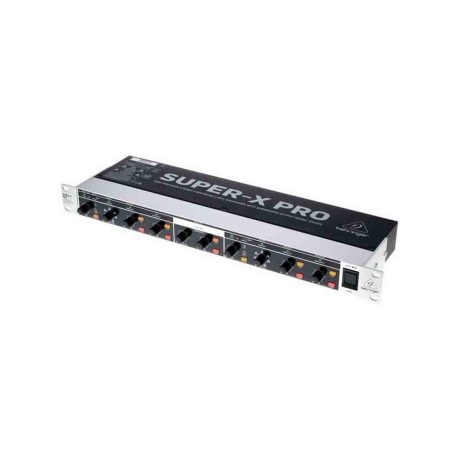| Content |
The XR-Series crossovers are the product of an intensive research effort started in 1972 which combined a reexamination of traditional crossover theory with practical field use. Over the years, a number of refinements and new models have been added to our crossover series, but the original design goals have remained the same: to produce a crossover which is sonically accurate, is flexible enough to suit a wide variety of systems, and affords maximum protection for speakers and drivers.
All Ashly crossovers are based upon the same powerful state-variable filter circuit, which guarantees that two adjacent frequency band outputs always remain in phase. Our crossovers offer a number of useful and unusual features, including continuous tuning, a response control, and a unique output stage which maintains low noise at any level setting. These models also include a 200:1 tuning range, output mute switches, and both TRS and XLR connectors. Like other Ashly products, your crossover features low noise and distortion, active balanced inputs, a peak level indicator, a precision regulated power supply, protection against abnormal input or output conditions, and rugged mechanical construction. Conservative design and an unusually thorough procedure for quality control have earned Ashly a reputation for dependability in the recording, sound reinforcement, and broadcast fields.
Response Control an Ashly Exclusive...
This control, found adjacent to the crossover frequency control, adjusts the damping of the filter affecting the response shape of the filters at the crossover point. The dial calibrations refer to the amount of attenuation effected by the filter at the crossover frequency, i.e., a setting of 3dB means that the filter's high-pass and low-pass outputs are each "rolled off 3dB at the crossover point“. This describes Butterworth filter response, or a gentle 3dB peak at the crossover point when the two filter output signals overlap. To obtain a flat signal, or "Linkowitz-Riley" response through the crossover region, set the Response control to "6“. This attenuates each output of the filter by 6dB at the crossover point (two identical signals added together yield a +6dB increase). To obtain a notch at the crossover point, turn down the response control past "6" to best suit your needs.
The purpose of this control is to help offset the inaccuracies inherent in typical loudspeakers, thereby helping you to achieve a flat system response. NOTE: The Response control is not a "slope" control. A 24dB/octave crossover will always have a slope of 24dB/octave. The Response control only affects filter response shape in the immediate vicinity of the crossover frequency; the ultimate crossover slope is a fixed parameter.
|
24dB/Octave Slopes |
|
Variable Filter Response Allows Tuning-In Linkwitz-Riley or Other Filters |
|
Output Mute Switches |
|
Balanced Inputs and Outputs |
|
20Hz Third Order High Pass Filter |
|
XLR and 1/4" TRS Audio Connections |
|
Peak Overload Warning LEDs |
|
Five Year Warranty | |
Based on a two-in, six-out topology, the DC-One is designed primarily for users of small-to-medium sized sound systems in both mobile and installed applications. While the unit is an all-new development based on a powerful SHARC processor, it is 100 percent compatible with all settings from other Electro-Voice signal processors. A large part of DC-Oneʼs development was aimed at ensuring that users can easily handle its serious digital horsepower and high-end audio performance. Free. PC-Editor software is available, or the DC-One can be operated via the front panel.
A/D Conversion 24-Bit Delta-Sigma
A/D Conversion 24-bit/sigma-delta (linear phase) 128 times oversampling
Analog Inputs 2 XLR (Electronically Balanced), 2 XLR THRU OUT (Electronically Balanced)
Analog Outputs 6 XLR (Electronically Balanced)
Control Protocol Front Panel USB Connector
D/A Conversion 24-bit/sigma-delta 128 times oversampling
D/A Conversion 24-Bit Delta-Sigma
Data Format 24-Bit
Digital Inputs 1 XLR AES/EBU (2 Ch)
Dynamic Range 111 dB (unweighted, band limited 22 Hz - 22 kHz)
Electronics Type Processor
FIR-Drive No
Frequency Response 10 Hz - 22 kHz (±0.5 dB)
Input Impedance (Balanced) 10 kΩ
Internal Processing 32-Bit Floating Point
Mains Voltage 100-240 VAC
Maximum Input Voltage 8.7 V / +21 dBu (Without -6 dB Analog Pad Engaged)
Maximum Output Voltage 8.7 V / +21 dBu
Nominal Input Voltage 1.23 V / +4 dBu
Nominal Output Voltage 1.23 V / +4 dBu
Output Impedance (Balanced) 50 Ω
Power Consumption 25 W
Sample Rate 48 kHz
THD+N < 0.01% (band limited 22 Hz - 22 kHz)
Height 1RU 44.45 mm (1.75“)
Width 482.6 mm (19“)
Depth 355.6 mm (14“)
Weight Net 4.6 kg (10.14 lbs) | Behringer CX-3400 3-Way Stero/4-Way Mono Frequency Crossover with Limiters
The CX3400 is an active frequency crossover enabling 2 or 3-way stereo or even 4-way mono operation. Each band features two 24-dB Linkwitz-Riley filters, as well as individual IGC limiters, while the integrated delay enables flexible time alignment. Polarity switches for each output allow quick and easy runtime compensation for various driver and horn types.2
Respectively:
3-Way stereo or 4-way mono
24 dB / octave Linkwitz-Riley filter
Mono-Sub switchable
LF / HF gain regular / mutable
CD horn EQ switchable
Vertex frequency tunable
Factor switching (10x)
Multi-band limiter switch / variable (threshold)
Limit display each way
LF Delay (max 2ms / 60cm)
Phase reverse
25 Hz subsonic filter, sym
XLR in / out with multiband limiters
Dimensions: 19", 1U, 147 mm case depth
Weight: 1.7 kg | Crossover 2-Way stereo or 3-way mono mode Additional subwoofer output Linkwitz-Riley filter with 24 dB / octave Sub-woofer frequency range separately adjustable Individual output gain controls and output mute switch for all bands 2 Balanced XLR inputs with gold-plated contacts 5 Balanced XLR outputs with gold-plated contacts Switchable 25 Hz low-cut filter to protect loudspeakers from infrasound Easy-to-read status LEDs Built-in power supply 100-240V, 50-60 Hz Dimensions (H x W x D): 44 x 483 x 147 mm Weight: 1.6 kg |
Full-featured Speaker Processing in a 1U Space
Speaker processing can be a complicated business requiring a substantial array of equipment, but the Yamaha SP2060 offers everything you need in a single rack space. This innovative 24-bit, 96-kHz digital speaker processor delivers excellent sound quality, an impressive variety of processing functions — gain, delay, PEQ, comp, crossover, limiter, and an all-pass filter for phase adjustment — and intuitive programming from Yamaha's DME Designer application running on a personal computer. It has two analog inputs and six analog outputs, plus two AES/EBU format digital inputs for connectivity with a broad range of systems. And if you use Yamaha Installation Series Speakers, all you need to do is select one of the many optimized presets provided for great sound with minimum measurement and setup time. The SP2060 is a compact, portable 1U unit that is ideal for live sound or installations.
| Sampling Frequency | Internal Clock | 96kHz | | External Clock | Normal Rate | 44.1, 48kHz (±0.1%) | | Double Rate | 88.2, 96kHz (±0.1%) | | Signal Delay | 761µsec Input to Output, fs = 96kHz | | Frequency Response | 20Hz -40kHz (TYP 0dB, MAX +0.5dB, MIN -1.0dB), fs=96kHz, RL=600ohms | | Total Harmonic Distortion | 0.007% (+22dBu@1 kHz),
0.05% (+4dBµ@20 Hz - 40kHz)
fs=96kHz, RL=600ohms;
measured with 18dB/octave filter @80kHz | | Hum & Noise | TYP -82dBu,
fs=96kHz, RL=600ohms, Rs=150 ohms;
measured with 6dB/octave filter @12.7kHz;
equivalent to a 20kHz filter with ∞ dB/octave attenuation. | | Dynamic Range | 106dB AD+DA
fs=96kHz, RL=600ohms;
measured with 6dB/octave filter @12.7kHz;
equivalent to a 20kHz filter with ∞dB/octave attenuation. | | Crosstalk @1kHz | -80dB INPUT to Output
fs=96kHz, measured with 18dB/octave filter @80kHz | | Power Consumption | 30W | | Dimensions (W x H x D) | 480 x 44x 360.2mm | | Net Weight | 4.2kg |
|
- 2 analog inputs and 6 analog outputs for maximum flexibility
- High-end 96 kHz converters for ultimate signal integrity and wide dynamic range (120 dB)
- Precise Dynamic EQs for level-dependent equalization and extremely musical Parametric EQs, selectable for all inputs and outputs
- Several types of EQs (LP/BP/HP) for each input and output
- “Zero“-attack Limiters on all output channels for optimal speaker protection
- Four different mono and stereo output operating modes
- Individual crossover filter types (Butterworth, Bessel and Linkwitz-Riley) with selectable roll-off characteristics from 6 to 48 dB/octave
- Adjustable Delays for all inputs and outputs—allow manual or automatic correction for room temperature, phase and arrival time differences
- 60 user-defined internal presets storable
- Servo-balanced, gold-plated XLR connectors for all inputs and outputs
- Internal switch-mode power supply for maximum flexibility (100 - 240 V~), noise-free audio, superior transient response plus low power consumption for energy saving
- High-quality components and exceptionally rugged construction ensure long life
- Conceived and designed by BEHRINGER Germany
|

















Reviews
There are no reviews yet.